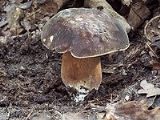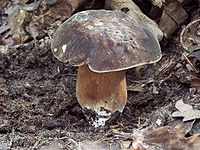
Boletus aereus
Encyclopedia
Boletus aereus is a bolete
, an edible mushroom
frequently consumed in the Basque Country, Navarre
, France
and Italy
. It is commonly known as ontto beltza in Basque
, porcino nero in Italian
, and tête de nègre (negro’s head) in French
. As a member of the Boletaceae
family, this mushroom has tubes and pores, instead of gills beneath its cap.
and Boletus pinophilus
. In 2008, a taxonomic revision of western North American populations initially thought to represent Boletus aereus, formally established them as a separate species, Boletus regineus.
 The height of this boletus is 15–20 cm, broad at maturity; specimens of 40 cm have been found in some cases. The cap
The height of this boletus is 15–20 cm, broad at maturity; specimens of 40 cm have been found in some cases. The cap
is dark brown and the ringless stalk
is 6–10 cm high, usually shorter than the cap diameter. The pores are greyish white when young, then become yellow.
. Mushrooms are found in summer and autumn.
. The similar Boletus regineus
(the Queen bolete) is widely collected by both amateur and commercial collectors in California.
Boletus
Boletus is a genus of mushroom, comprising over 100 species. The genus Boletus was originally broadly defined and described by Elias Magnus Fries in 1821, essentially containing all fungi with pores...
, an edible mushroom
Edible mushroom
Edible mushrooms are the fleshy and edible fruiting bodies of several species of fungi. Mushrooms belong to the macrofungi, because their fruiting structures are large enough to be seen with the naked eye. They can appear either below ground or above ground where they may be picked by hand...
frequently consumed in the Basque Country, Navarre
Navarre
Navarre , officially the Chartered Community of Navarre is an autonomous community in northern Spain, bordering the Basque Country, La Rioja, and Aragon in Spain and Aquitaine in France...
, France
France
The French Republic , The French Republic , The French Republic , (commonly known as France , is a unitary semi-presidential republic in Western Europe with several overseas territories and islands located on other continents and in the Indian, Pacific, and Atlantic oceans. Metropolitan France...
and Italy
Italy
Italy , officially the Italian Republic languages]] under the European Charter for Regional or Minority Languages. In each of these, Italy's official name is as follows:;;;;;;;;), is a unitary parliamentary republic in South-Central Europe. To the north it borders France, Switzerland, Austria and...
. It is commonly known as ontto beltza in Basque
Basque language
Basque is the ancestral language of the Basque people, who inhabit the Basque Country, a region spanning an area in northeastern Spain and southwestern France. It is spoken by 25.7% of Basques in all territories...
, porcino nero in Italian
Italian language
Italian is a Romance language spoken mainly in Europe: Italy, Switzerland, San Marino, Vatican City, by minorities in Malta, Monaco, Croatia, Slovenia, France, Libya, Eritrea, and Somalia, and by immigrant communities in the Americas and Australia...
, and tête de nègre (negro’s head) in French
French language
French is a Romance language spoken as a first language in France, the Romandy region in Switzerland, Wallonia and Brussels in Belgium, Monaco, the regions of Quebec and Acadia in Canada, and by various communities elsewhere. Second-language speakers of French are distributed throughout many parts...
. As a member of the Boletaceae
Boletaceae
Boletaceae are a family of mushrooms, primarily characterized by developing their spores in small pores on the underside of the mushroom, instead of gills, as are found in agarics. Nearly as widely distributed as agarics, they include the Cep or King Bolete , much sought after by mushroom hunters...
family, this mushroom has tubes and pores, instead of gills beneath its cap.
Taxonomy
This species is classified in Boletus section Boletus, alongside its close relatives which include Boletus edulisBoletus edulis
Boletus edulis, commonly known as penny bun, porcino or cep, is a basidiomycete fungus, and the type species of the genus Boletus. Widely distributed in the Northern Hemisphere across Europe, Asia, and North America, it does not occur naturally in the Southern Hemisphere, although it has been...
and Boletus pinophilus
Boletus pinophilus
Boletus pinophilus, commonly known as the pine bolete or pinewood king bolete, is a basidiomycete fungus of the genus Boletus found throughout Europe. The large, edible fruiting bodies known as mushrooms appear under pine trees, generally in summer and autumn...
. In 2008, a taxonomic revision of western North American populations initially thought to represent Boletus aereus, formally established them as a separate species, Boletus regineus.
Description

Pileus (mycology)
The pileus is the technical name for the cap, or cap-like part, of a basidiocarp or ascocarp that supports a spore-bearing surface, the hymenium. The hymenium may consist of lamellae, tubes, or teeth, on the underside of the pileus...
is dark brown and the ringless stalk
Stipe (mycology)
thumb|150px|right|Diagram of a [[basidiomycete]] stipe with an [[annulus |annulus]] and [[volva |volva]]In mycology a stipe refers to the stem or stalk-like feature supporting the cap of a mushroom. Like all tissues of the mushroom other than the hymenium, the stipe is composed of sterile hyphal...
is 6–10 cm high, usually shorter than the cap diameter. The pores are greyish white when young, then become yellow.
Distribution and habitat
Boletus aereus is found mainly in central and southern Europe, being rare in colder climes such as EnglandEngland
England is a country that is part of the United Kingdom. It shares land borders with Scotland to the north and Wales to the west; the Irish Sea is to the north west, the Celtic Sea to the south west, with the North Sea to the east and the English Channel to the south separating it from continental...
. Mushrooms are found in summer and autumn.
Edibility
It is well known in southern Europe for its culinary qualities, and is appreciated by some even more than Boletus edulisBoletus edulis
Boletus edulis, commonly known as penny bun, porcino or cep, is a basidiomycete fungus, and the type species of the genus Boletus. Widely distributed in the Northern Hemisphere across Europe, Asia, and North America, it does not occur naturally in the Southern Hemisphere, although it has been...
. The similar Boletus regineus
Boletus regineus
Boletus regineus, commonly known as the queen bolete, is an edible and highly regarded fungus of the Boletus family that inhabits southwestern North America. It was considered a variant of the similarly edible B. edulis for many years until declared a unique species in 2008. Phylogenetic analysis...
(the Queen bolete) is widely collected by both amateur and commercial collectors in California.

